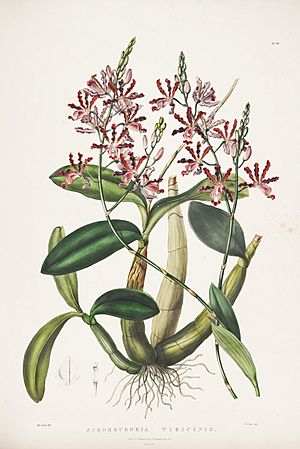Myrmecophila tibicinis facts for kids
Quick facts for kids Myrmecophila tibicinis |
|
|---|---|
 |
|
| Myrmecophila tibicinis (illust. Sarah Ann Drake) | |
| Scientific classification | |
| Genus: |
Myrmecophila
|
| Species: |
tibicinis
|
| Synonyms | |
|
Bletia tibicinis (Bateman ex Lindl.) Rchb.f. |
|
Myrmecophila tibicinis is a beautiful type of orchid flower. It belongs to a group of orchids called Myrmecophila. People sometimes call it the trumpet player's Schomburgkia because of its shape.
This orchid was first described in 1838 by a person named Bateman. Later, in 1917, Rolfe officially placed it in the Myrmecophila genus.
Where This Orchid Grows
This special orchid grows in places with dry forests. You can find it in countries like Belize, Costa Rica, Guatemala, Honduras, Venezuela, and Colombia.
It likes to grow on the trunks and big branches of trees. It prefers sunny spots, usually at heights between 300 and 600 meters (about 980 to 1,970 feet) above sea level.
A Home for Ants
One of the most interesting things about Myrmecophila tibicinis is its large pseudobulbs. These are like swollen stems that store water and nutrients. They can grow quite big, up to 45 centimeters (about 18 inches) long.
In the wild, these pseudobulbs often have ants living inside them! The ants make their homes there, and in return, their waste helps to feed the orchid. It's a cool example of how plants and animals can help each other.
How to Tell it Apart
Sometimes, Myrmecophila tibicinis can look a bit like another orchid called M. brysiana. However, there are ways to tell them apart.
Myrmecophila tibicinis usually has bigger flowers that are a lovely magenta color. Its central part, called the column, is also larger. In contrast, M. brysiana has smaller, yellow flowers.
See also
 In Spanish: Flor de cacho para niños
In Spanish: Flor de cacho para niños

